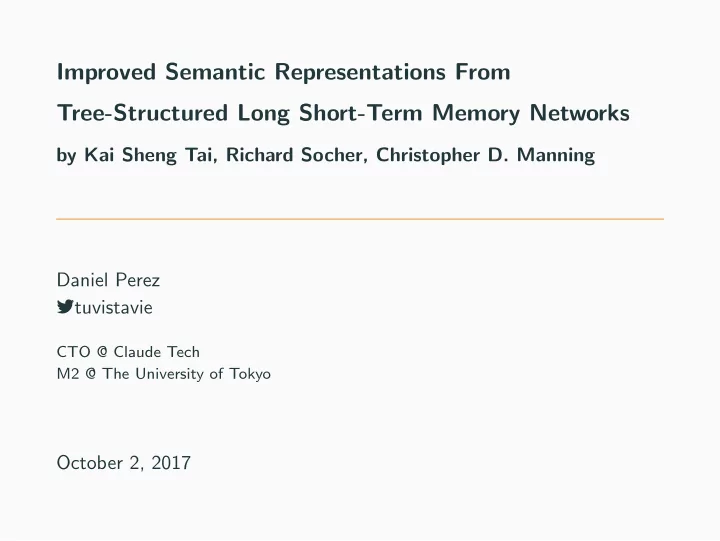

Improved Semantic Representations From Tree-Structured Long Short-Term Memory Networks by Kai Sheng Tai, Richard Socher, Christopher D. Manning Daniel Perez � tuvistavie CTO @ Claude Tech M2 @ The University of Tokyo October 2, 2017
Distributed representation of words Idea Encode each word using a vector in R d , such that words with similar meanings are close in the vector space. 2
Representing sentences Limitation Good representation of words is not enough to represent sentences The man driving the aircraft is speaking. vs The pilot is making an announce. 3
Recurrent Neural Networks Idea Add state to the neural network by reusing the last output as an input of the model 4
Basic RNN cell In a plain RNN, h t is computed as follow h t = tanh( Wx t + Uh t − 1 + b ) given, g ( x t , h t − 1 ) = Wx t + Uh t − 1 + b , 5
Basic RNN cell In a plain RNN, h t is computed as follow h t = tanh( Wx t + Uh t − 1 + b ) given, g ( x t , h t − 1 ) = Wx t + Uh t − 1 + b , Issue Because of vanishing gradients, gradients do not propagate well through the network: impossible to learn long-term dependencies 5
Long short-term memory (LSTM) Goal Improve RNN architecture to learn long term dependencies Main ideas • Add a memory cell which does not suffer vanishing gradient • Use gating to control how information propagates 6
LSTM cell Given g n ( x t , h t − 1 ) = W ( n ) x t + U ( n ) h t − 1 + b ( n ) 7
Structure of sentences Sentences are not a simple linear sequence. The man driving the aircraft is speaking. 8
Structure of sentences Sentences are not a simple linear sequence. The man driving the aircraft is speaking. Constituency tree 8
Structure of sentences Sentences are not a simple linear sequence. The man driving the aircraft is speaking. Dependency tree 8
Tree-structured LSTMs Goal Improve encoding of sentences by using their structures Models • Child-sum tree LSTM Sums over all the children of a node: can be used for any number of children • N-ary tree LSTM Use different parameters for each node: better granularity, but maximum number of children per node must be fixed 9
Child-sum tree LSTM Children outputs and memory cells are summed Child-sum tree LSTM at node j with children k 1 and k 2 10
Child-sum tree LSTM Properties • Does not take into account children order • Works with variable number of children • Shares gates weight (including forget gate) between children Application Dependency Tree-LSTM: number of dependents is variable 11
N-ary tree LSTM Given g ( n ) l =1 U ( n ) k ( x t , h l 1 , · · · , h l N ) = W ( n ) x t + � N kl h jl + b ( n ) Binary tree LSTM at node j with children k 1 and k 2 12
N -ary tree LSTM Properties • Each node must have at most N children • Fine-grained control on how information propagates • Forget gate can be parameterized so that siblings affect each other Application Constituency Tree-LSTM: using a binary tree LSTM 13
Sentiment classification Task Predict sentiment ˆ y j of node j Sub-tasks • Binary classification • Fine-grained classification over 5 classes Method • Annotation at node level • Uses negative log-likelihood error � W ( s ) h j + b ( s ) � p θ ( y |{ x } j ) = softmax ˆ y j = arg max ˆ p θ ( y |{ x } j ) ˆ y 14
Sentiment classification results Constituency Tree-LSTM performs best on fine-grained sub-task Method Fine-grained Binary CNN-multichannel 47.4 88.1 LSTM 46.4 84.9 Bidirectional LSTM 49.1 87.5 2-layer Bidirectional LSTM 48.5 87.2 Dependency Tree-LSTM 48.4 85.7 Constituency Tree-LSTM - randomly initialized vectors 43.9 82.0 - Glove vectors, fixed 49.7 87.5 - Glove vectors, tuned 51.0 88.0 15
Semantic relatedness Task Predict similarity score in [1 , K ] between two sentences Method Similarity between sentences L and R annotated with score ∈ [1 , 5] • Produce representations h L and h R • Compute distance h + and angle h × between h L and h R • Compute score using fully connected NN � W ( × ) h × + W (+) h + + b ( h ) � h s = σ � W ( p ) h s + b ( p ) � p θ = softmax ˆ y = r T ˆ ˆ r = [1 , 2 , 3 , 4 , 5] p θ • Error is computed using KL-divergence 16
Semantic relatedness results Dependency Tree-LSTM performs best for all measures Method Pearson’s r MSE LSTM 0.8528 0.2831 Bidirectional LSTM 0.8567 0.2736 2-layer Bidirectional LSTM 0.8558 0.2762 Constituency Tree-LSTM 0.8582 0.2734 Dependency Tree-LSTM 0.8676 0.2532 17
Summary • Tree-LSTMs allow to encode tree topologies • Can be used to encode sentences parse trees • Can capture longer and more fine-grained words dependencies 18
References Christopher Olah. Understanding lstm networks, 2015. Kai Sheng Tai, Richard Socher, and Christopher D Manning. Improved Semantic Representations From Tree-Structured Long Short-Term Memory Networks. 2015. 19
Recommend
More recommend